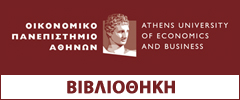| Abstract : | Σε αυτή τη μελέτη παρουσιάζουμε τους διάφορους τύπους χρηματοοικονομικών κινδύνων και τα πιο δημοφιλή μέτρα κινδύνου. Εξετάζουμε τα διάφορα είδη παραγώγων και τον τρόπο με τον οποίο μπορούν να χρησιμοποιηθούν για τη μείωση των κινδύνων που συνδέονται με τις μεταβολές των συναλλαγματικών ισοτιμιών, των επιτοκίων και των τιμών των βασικών εμπορευμάτων. Στην εμπειρική μας εφαρμογή χρησιμοποιούμε τη γλώσσα προγραμματισμού GAMS (General Algebraic Modeling System) για να λύσουμε το γραμμικό πρόβλημα βελτιστοποίησης CVaR. Μεγιστοποιούμε το CVaR επειδή χρησιμοποιούμε τις αποδόσεις και θέλουμε να βρούμε τα βέλτιστα βάρη των μετοχών ώστε να έχουμε ένα χαρτοφυλάκιο που θα έχει τις μέγιστες δυνατές αποδόσεις στο χειρότερο σενάριο με πιθανότητα 5% (α = 95%). Με αυτόν τον ορισμό κατασκευάζουμε το αμυντικό (ή MVP) χαρτοφυλάκιο και όταν εισάγουμε μια ελάχιστη απόδοση ως περιορισμό λαμβάνουμε το μεσαίο χαρτοφυλάκιο. Επιπλέον, το επιθετικό χαρτοφυλάκιο θα κατασκευαστεί με μόνο περιορισμό την μέγιστη απόδοση, με άλλα λόγια τη μετοχή με τη μέση υψηλότερη απόδοση σε αυτή την περίοδο. Επιπλέον, εκτελούμε στατικές δοκιμές για να κατασκευάσουμε το αποτελεσματικό σύνορο και δυναμικές δοκιμές μέσω backtesting για να δούμε τις πραγματικές αποδόσεις που θα είχε το κάθε χαρτοφυλάκιο. Τέλος, χρησιμοποιούμε τα συμβόλαια μελλοντικής εκπλήρωσης (futures) σε μια προσπάθεια αντιστάθμισης του κινδύνου και συγκρίνουμε τα αποτελέσματα των αντισταθμιζόμενων και των μη αντισταθμιζόμενων χαρτοφυλακίων.
In this study we present the various types of financial risks and the most popular risk measures. We also explore the different types of derivatives and how it can be used to reduce the risks associated with changes in foreign exchange rates, interest rates, and commodity prices. In our empirical application we use GAMS (General Algebraic Modeling System) to solve the linear CVaR optimization problem. We maximize the CVaR because we use returns and we want to find the optimal weights of stocks that we will result in a portfolio that will have the maximum possible returns in the worst 5% scenario (α=95%). With this definition we construct the defensive (or MVP) portfolio and when we insert a target (or minimum) return as constraint we take the middle portfolio. Moreover the aggressive portfolio will be constructed with only constraint the maximum return, in other words the stock with the average highest return in this period. Furthermore we run static tests to construct the CVaR efficient frontier and dynamic tests through backtesting to see the real returns that will have every portfolio. Finally we use futures in an attempt to offset risk and we compare the results of the hedged and the unhedged portfolios.
|
|---|







 Copyright © 2013 Library AUEB. All rights reserved.
Copyright © 2013 Library AUEB. All rights reserved.